MBA Entrance Exam: Assessment of Marketing, Management, Finance Skills
VerifiedAdded on 2022/10/12
|25
|5853
|428
Quiz and Exam
AI Summary
This document presents a comprehensive MBA entrance exam designed for the SBS Swiss Business School, focusing on five key assessment indicators: Marketing, Management, Finance, Managerial Accounting, and Strategic Integration. The exam is structured as an individual assessment, prohibiting the use of external resources or assistance. Each section—Marketing and Management—consists of multiple-choice questions testing the candidate's understanding of core business concepts. The Marketing section covers topics such as corporate retailing, market intelligence, direct-response marketing, holistic marketing, and global industry dynamics. The Management section focuses on interorganizational relationships, managerial functions (planning, organizing, leading, and controlling), and strategic decision-making. The Finance section, though incomplete, suggests a focus on financial concepts and applications, potentially including topics such as currency valuation and financial analysis. This exam serves as a valuable tool for MBA applicants to assess their knowledge and prepare for the rigorous demands of business school.
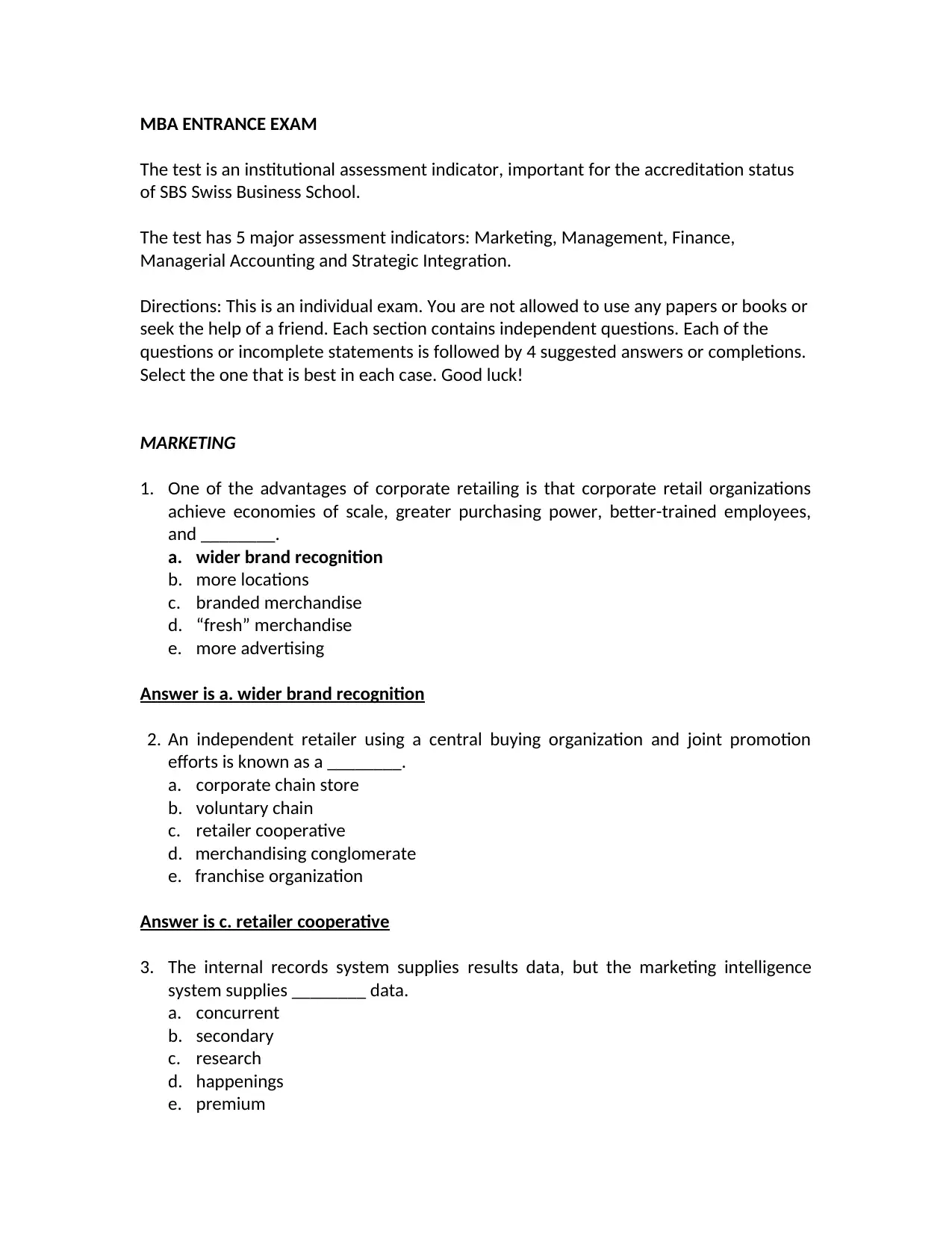
MBA ENTRANCE EXAM
The test is an institutional assessment indicator, important for the accreditation status
of SBS Swiss Business School.
The test has 5 major assessment indicators: Marketing, Management, Finance,
Managerial Accounting and Strategic Integration.
Directions: This is an individual exam. You are not allowed to use any papers or books or
seek the help of a friend. Each section contains independent questions. Each of the
questions or incomplete statements is followed by 4 suggested answers or completions.
Select the one that is best in each case. Good luck!
MARKETING
1. One of the advantages of corporate retailing is that corporate retail organizations
achieve economies of scale, greater purchasing power, better-trained employees,
and ________.
a. wider brand recognition
b. more locations
c. branded merchandise
d. “fresh” merchandise
e. more advertising
Answer is a. wider brand recognition
2. An independent retailer using a central buying organization and joint promotion
efforts is known as a ________.
a. corporate chain store
b. voluntary chain
c. retailer cooperative
d. merchandising conglomerate
e. franchise organization
Answer is c. retailer cooperative
3. The internal records system supplies results data, but the marketing intelligence
system supplies ________ data.
a. concurrent
b. secondary
c. research
d. happenings
e. premium
The test is an institutional assessment indicator, important for the accreditation status
of SBS Swiss Business School.
The test has 5 major assessment indicators: Marketing, Management, Finance,
Managerial Accounting and Strategic Integration.
Directions: This is an individual exam. You are not allowed to use any papers or books or
seek the help of a friend. Each section contains independent questions. Each of the
questions or incomplete statements is followed by 4 suggested answers or completions.
Select the one that is best in each case. Good luck!
MARKETING
1. One of the advantages of corporate retailing is that corporate retail organizations
achieve economies of scale, greater purchasing power, better-trained employees,
and ________.
a. wider brand recognition
b. more locations
c. branded merchandise
d. “fresh” merchandise
e. more advertising
Answer is a. wider brand recognition
2. An independent retailer using a central buying organization and joint promotion
efforts is known as a ________.
a. corporate chain store
b. voluntary chain
c. retailer cooperative
d. merchandising conglomerate
e. franchise organization
Answer is c. retailer cooperative
3. The internal records system supplies results data, but the marketing intelligence
system supplies ________ data.
a. concurrent
b. secondary
c. research
d. happenings
e. premium
Paraphrase This Document
Need a fresh take? Get an instant paraphrase of this document with our AI Paraphraser
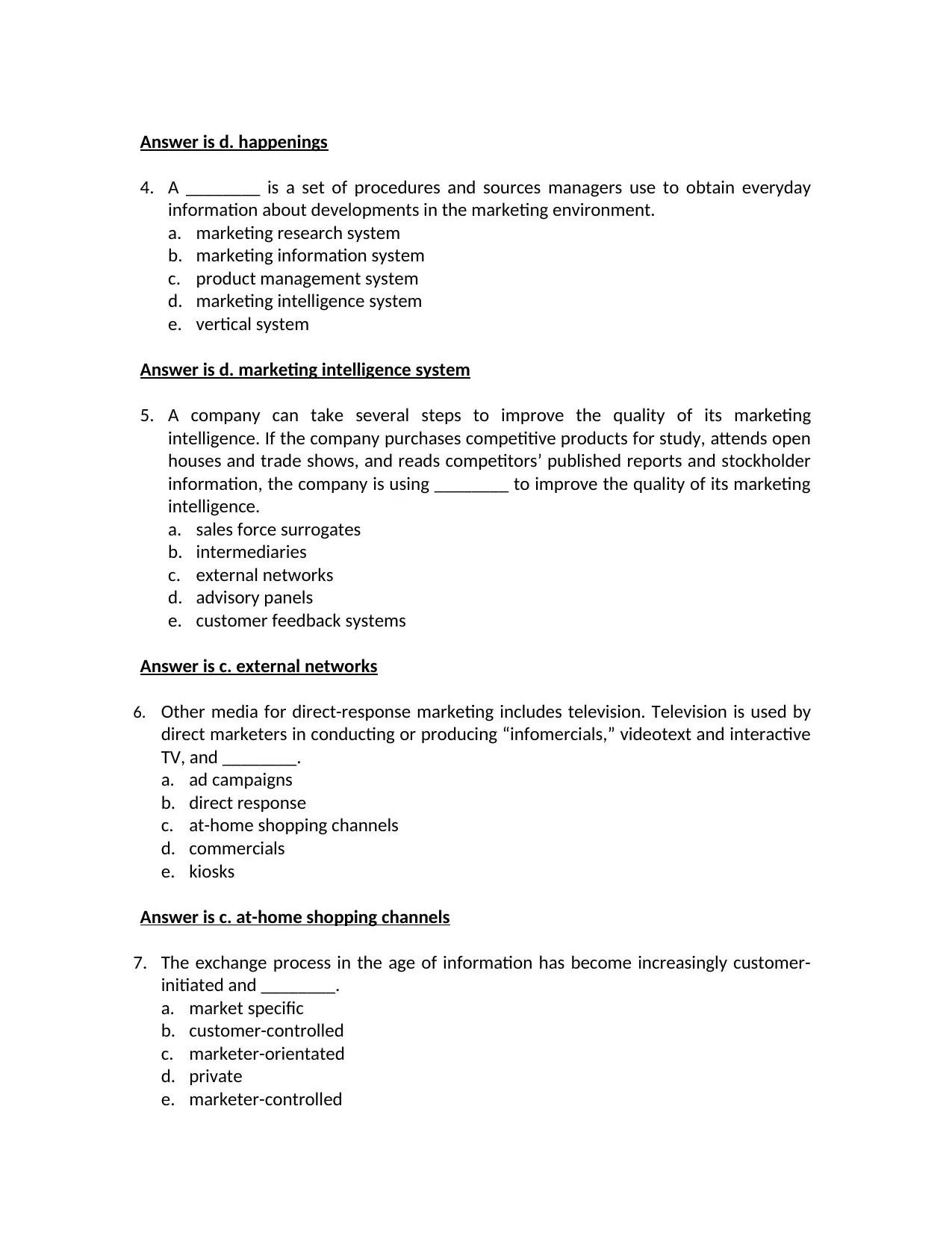
Answer is d. happenings
4. A ________ is a set of procedures and sources managers use to obtain everyday
information about developments in the marketing environment.
a. marketing research system
b. marketing information system
c. product management system
d. marketing intelligence system
e. vertical system
Answer is d. marketing intelligence system
5. A company can take several steps to improve the quality of its marketing
intelligence. If the company purchases competitive products for study, attends open
houses and trade shows, and reads competitors’ published reports and stockholder
information, the company is using ________ to improve the quality of its marketing
intelligence.
a. sales force surrogates
b. intermediaries
c. external networks
d. advisory panels
e. customer feedback systems
Answer is c. external networks
6. Other media for direct-response marketing includes television. Television is used by
direct marketers in conducting or producing “infomercials,” videotext and interactive
TV, and ________.
a. ad campaigns
b. direct response
c. at-home shopping channels
d. commercials
e. kiosks
Answer is c. at-home shopping channels
7. The exchange process in the age of information has become increasingly customer-
initiated and ________.
a. market specific
b. customer-controlled
c. marketer-orientated
d. private
e. marketer-controlled
4. A ________ is a set of procedures and sources managers use to obtain everyday
information about developments in the marketing environment.
a. marketing research system
b. marketing information system
c. product management system
d. marketing intelligence system
e. vertical system
Answer is d. marketing intelligence system
5. A company can take several steps to improve the quality of its marketing
intelligence. If the company purchases competitive products for study, attends open
houses and trade shows, and reads competitors’ published reports and stockholder
information, the company is using ________ to improve the quality of its marketing
intelligence.
a. sales force surrogates
b. intermediaries
c. external networks
d. advisory panels
e. customer feedback systems
Answer is c. external networks
6. Other media for direct-response marketing includes television. Television is used by
direct marketers in conducting or producing “infomercials,” videotext and interactive
TV, and ________.
a. ad campaigns
b. direct response
c. at-home shopping channels
d. commercials
e. kiosks
Answer is c. at-home shopping channels
7. The exchange process in the age of information has become increasingly customer-
initiated and ________.
a. market specific
b. customer-controlled
c. marketer-orientated
d. private
e. marketer-controlled
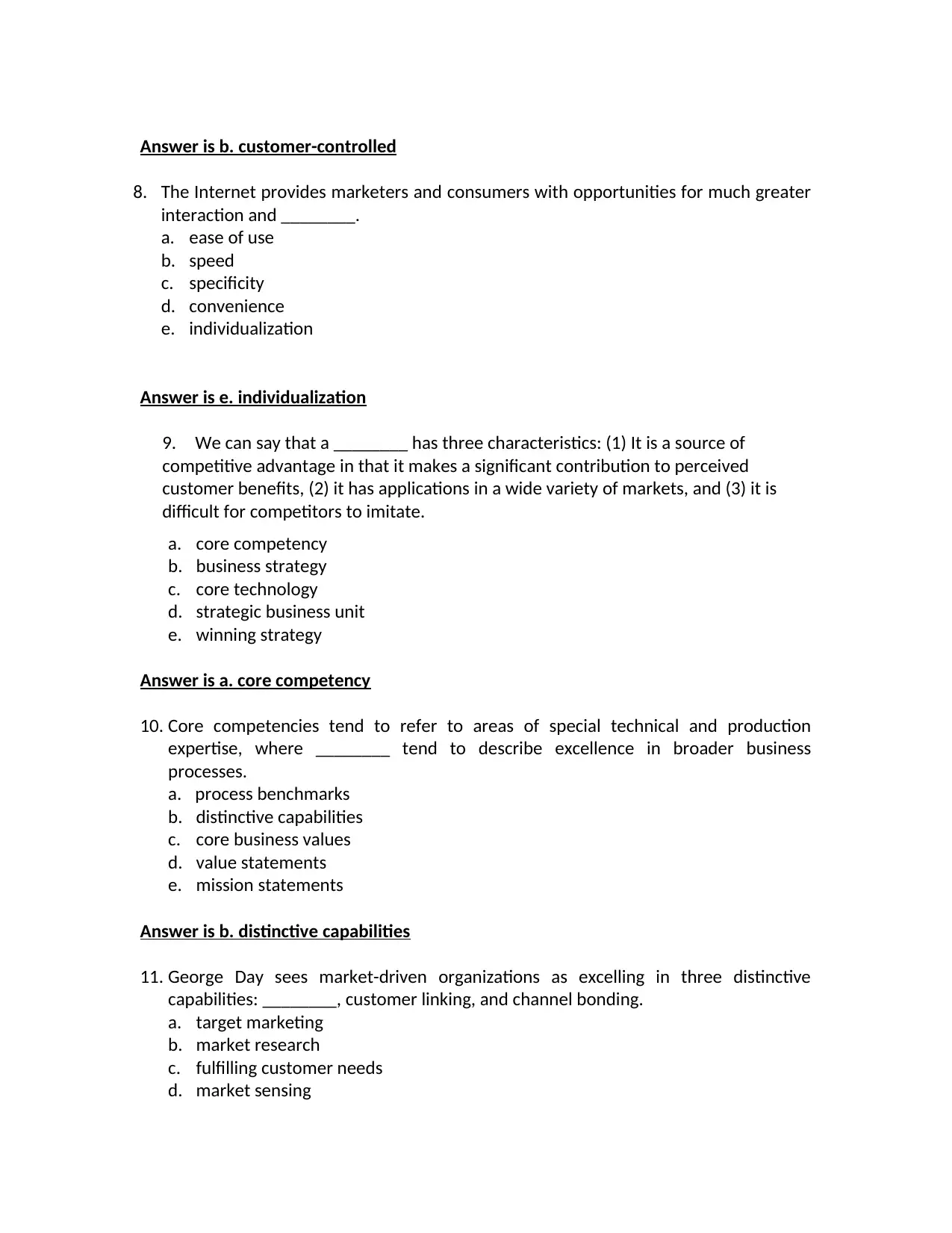
Answer is b. customer-controlled
8. The Internet provides marketers and consumers with opportunities for much greater
interaction and ________.
a. ease of use
b. speed
c. specificity
d. convenience
e. individualization
Answer is e. individualization
9. We can say that a ________ has three characteristics: (1) It is a source of
competitive advantage in that it makes a significant contribution to perceived
customer benefits, (2) it has applications in a wide variety of markets, and (3) it is
difficult for competitors to imitate.
a. core competency
b. business strategy
c. core technology
d. strategic business unit
e. winning strategy
Answer is a. core competency
10. Core competencies tend to refer to areas of special technical and production
expertise, where ________ tend to describe excellence in broader business
processes.
a. process benchmarks
b. distinctive capabilities
c. core business values
d. value statements
e. mission statements
Answer is b. distinctive capabilities
11. George Day sees market-driven organizations as excelling in three distinctive
capabilities: ________, customer linking, and channel bonding.
a. target marketing
b. market research
c. fulfilling customer needs
d. market sensing
8. The Internet provides marketers and consumers with opportunities for much greater
interaction and ________.
a. ease of use
b. speed
c. specificity
d. convenience
e. individualization
Answer is e. individualization
9. We can say that a ________ has three characteristics: (1) It is a source of
competitive advantage in that it makes a significant contribution to perceived
customer benefits, (2) it has applications in a wide variety of markets, and (3) it is
difficult for competitors to imitate.
a. core competency
b. business strategy
c. core technology
d. strategic business unit
e. winning strategy
Answer is a. core competency
10. Core competencies tend to refer to areas of special technical and production
expertise, where ________ tend to describe excellence in broader business
processes.
a. process benchmarks
b. distinctive capabilities
c. core business values
d. value statements
e. mission statements
Answer is b. distinctive capabilities
11. George Day sees market-driven organizations as excelling in three distinctive
capabilities: ________, customer linking, and channel bonding.
a. target marketing
b. market research
c. fulfilling customer needs
d. market sensing
⊘ This is a preview!⊘
Do you want full access?
Subscribe today to unlock all pages.

Trusted by 1+ million students worldwide
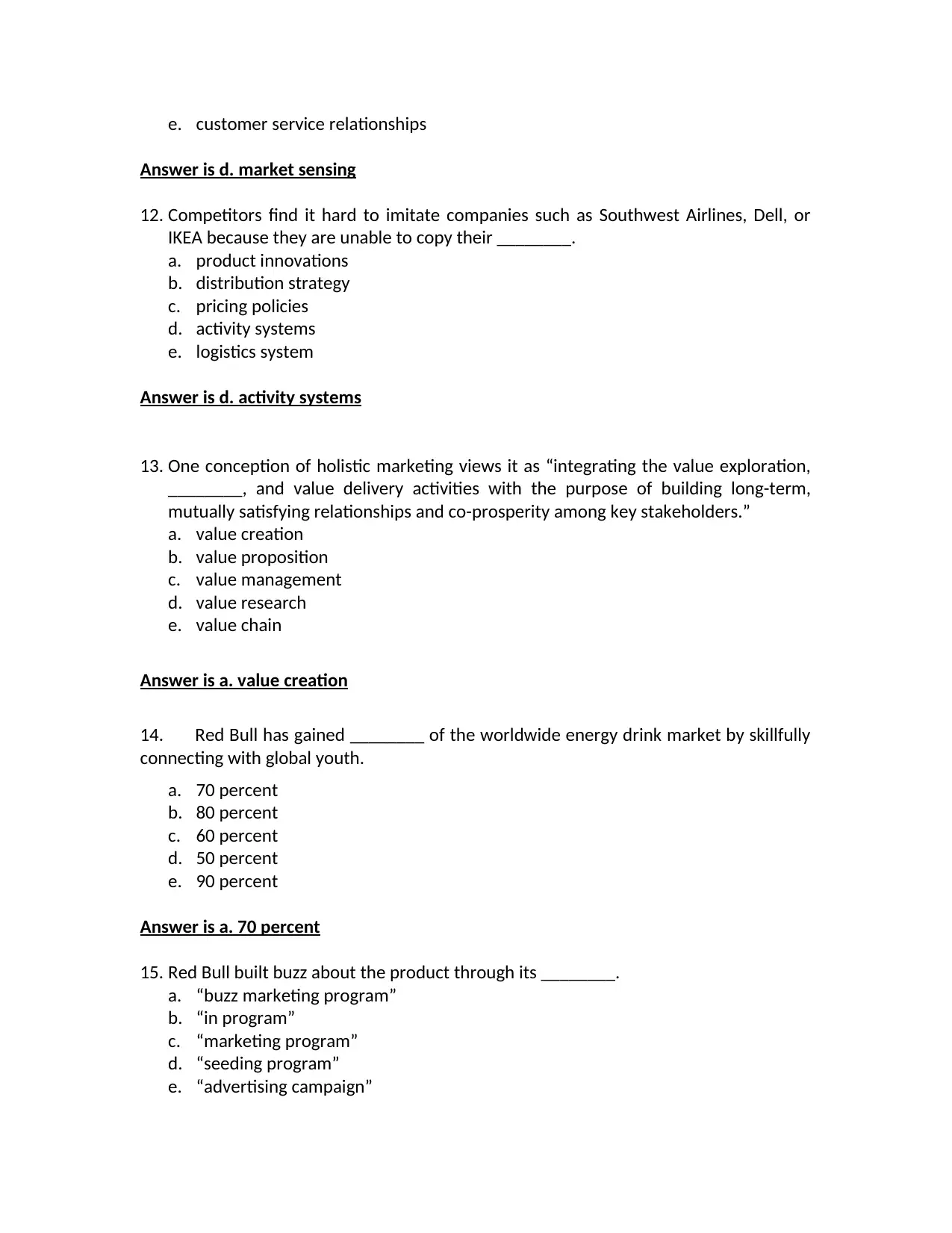
e. customer service relationships
Answer is d. market sensing
12. Competitors find it hard to imitate companies such as Southwest Airlines, Dell, or
IKEA because they are unable to copy their ________.
a. product innovations
b. distribution strategy
c. pricing policies
d. activity systems
e. logistics system
Answer is d. activity systems
13. One conception of holistic marketing views it as “integrating the value exploration,
________, and value delivery activities with the purpose of building long-term,
mutually satisfying relationships and co-prosperity among key stakeholders.”
a. value creation
b. value proposition
c. value management
d. value research
e. value chain
Answer is a. value creation
14. Red Bull has gained ________ of the worldwide energy drink market by skillfully
connecting with global youth.
a. 70 percent
b. 80 percent
c. 60 percent
d. 50 percent
e. 90 percent
Answer is a. 70 percent
15. Red Bull built buzz about the product through its ________.
a. “buzz marketing program”
b. “in program”
c. “marketing program”
d. “seeding program”
e. “advertising campaign”
Answer is d. market sensing
12. Competitors find it hard to imitate companies such as Southwest Airlines, Dell, or
IKEA because they are unable to copy their ________.
a. product innovations
b. distribution strategy
c. pricing policies
d. activity systems
e. logistics system
Answer is d. activity systems
13. One conception of holistic marketing views it as “integrating the value exploration,
________, and value delivery activities with the purpose of building long-term,
mutually satisfying relationships and co-prosperity among key stakeholders.”
a. value creation
b. value proposition
c. value management
d. value research
e. value chain
Answer is a. value creation
14. Red Bull has gained ________ of the worldwide energy drink market by skillfully
connecting with global youth.
a. 70 percent
b. 80 percent
c. 60 percent
d. 50 percent
e. 90 percent
Answer is a. 70 percent
15. Red Bull built buzz about the product through its ________.
a. “buzz marketing program”
b. “in program”
c. “marketing program”
d. “seeding program”
e. “advertising campaign”
Paraphrase This Document
Need a fresh take? Get an instant paraphrase of this document with our AI Paraphraser
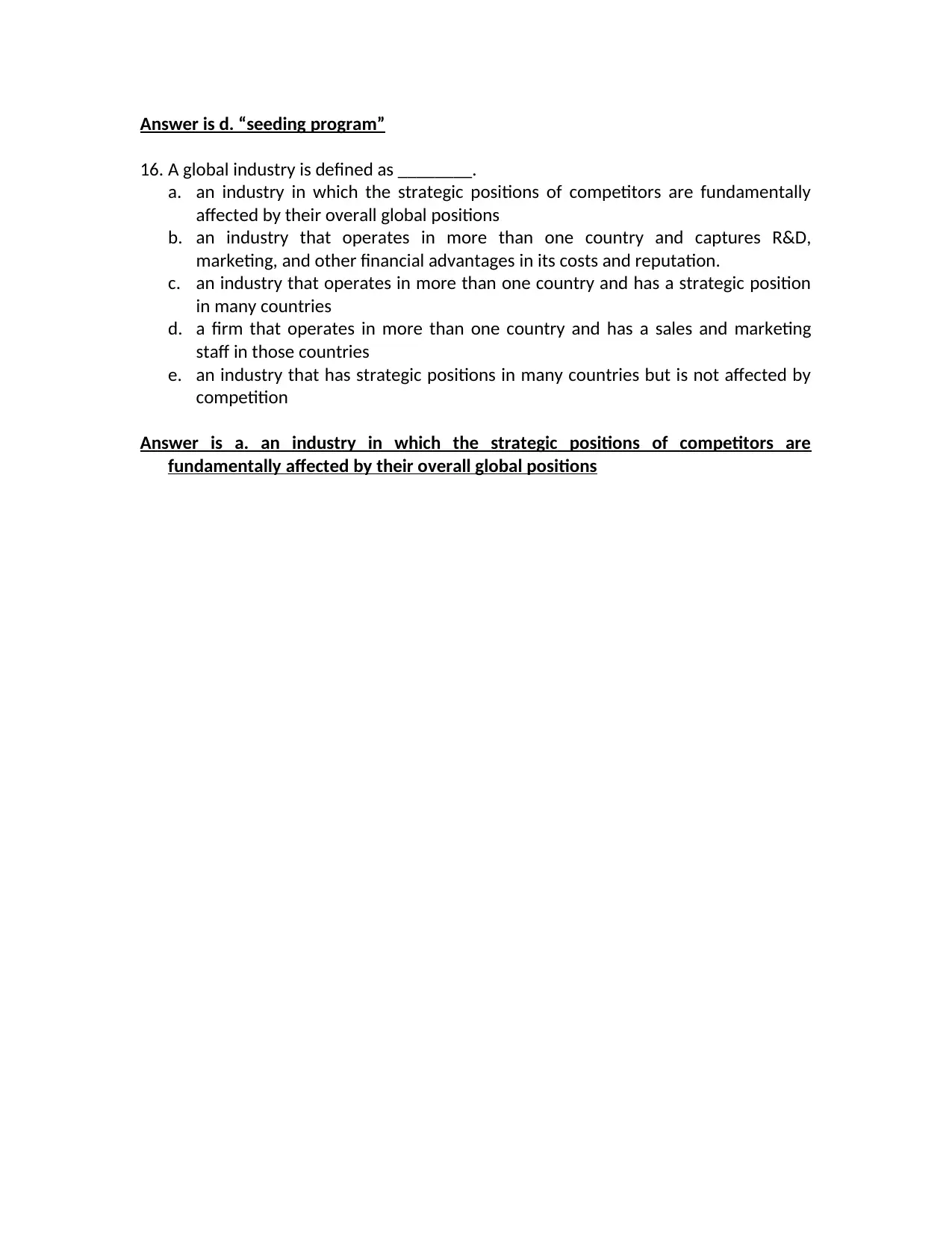
Answer is d. “seeding program”
16. A global industry is defined as ________.
a. an industry in which the strategic positions of competitors are fundamentally
affected by their overall global positions
b. an industry that operates in more than one country and captures R&D,
marketing, and other financial advantages in its costs and reputation.
c. an industry that operates in more than one country and has a strategic position
in many countries
d. a firm that operates in more than one country and has a sales and marketing
staff in those countries
e. an industry that has strategic positions in many countries but is not affected by
competition
Answer is a. an industry in which the strategic positions of competitors are
fundamentally affected by their overall global positions
16. A global industry is defined as ________.
a. an industry in which the strategic positions of competitors are fundamentally
affected by their overall global positions
b. an industry that operates in more than one country and captures R&D,
marketing, and other financial advantages in its costs and reputation.
c. an industry that operates in more than one country and has a strategic position
in many countries
d. a firm that operates in more than one country and has a sales and marketing
staff in those countries
e. an industry that has strategic positions in many countries but is not affected by
competition
Answer is a. an industry in which the strategic positions of competitors are
fundamentally affected by their overall global positions
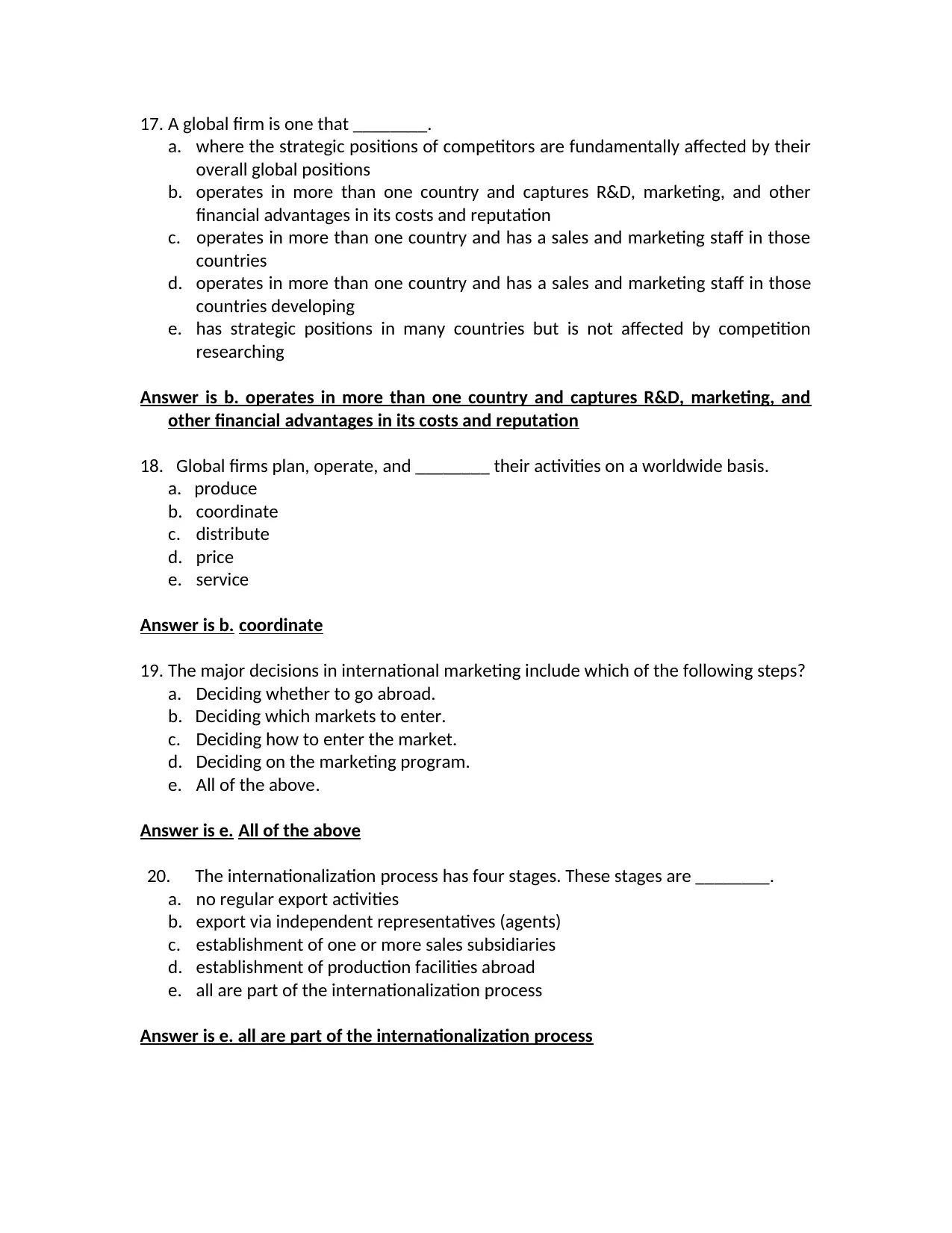
17. A global firm is one that ________.
a. where the strategic positions of competitors are fundamentally affected by their
overall global positions
b. operates in more than one country and captures R&D, marketing, and other
financial advantages in its costs and reputation
c. operates in more than one country and has a sales and marketing staff in those
countries
d. operates in more than one country and has a sales and marketing staff in those
countries developing
e. has strategic positions in many countries but is not affected by competition
researching
Answer is b. operates in more than one country and captures R&D, marketing, and
other financial advantages in its costs and reputation
18. Global firms plan, operate, and ________ their activities on a worldwide basis.
a. produce
b. coordinate
c. distribute
d. price
e. service
Answer is b. coordinate
19. The major decisions in international marketing include which of the following steps?
a. Deciding whether to go abroad.
b. Deciding which markets to enter.
c. Deciding how to enter the market.
d. Deciding on the marketing program.
e. All of the above.
Answer is e. All of the above
20. The internationalization process has four stages. These stages are ________.
a. no regular export activities
b. export via independent representatives (agents)
c. establishment of one or more sales subsidiaries
d. establishment of production facilities abroad
e. all are part of the internationalization process
Answer is e. all are part of the internationalization process
a. where the strategic positions of competitors are fundamentally affected by their
overall global positions
b. operates in more than one country and captures R&D, marketing, and other
financial advantages in its costs and reputation
c. operates in more than one country and has a sales and marketing staff in those
countries
d. operates in more than one country and has a sales and marketing staff in those
countries developing
e. has strategic positions in many countries but is not affected by competition
researching
Answer is b. operates in more than one country and captures R&D, marketing, and
other financial advantages in its costs and reputation
18. Global firms plan, operate, and ________ their activities on a worldwide basis.
a. produce
b. coordinate
c. distribute
d. price
e. service
Answer is b. coordinate
19. The major decisions in international marketing include which of the following steps?
a. Deciding whether to go abroad.
b. Deciding which markets to enter.
c. Deciding how to enter the market.
d. Deciding on the marketing program.
e. All of the above.
Answer is e. All of the above
20. The internationalization process has four stages. These stages are ________.
a. no regular export activities
b. export via independent representatives (agents)
c. establishment of one or more sales subsidiaries
d. establishment of production facilities abroad
e. all are part of the internationalization process
Answer is e. all are part of the internationalization process
⊘ This is a preview!⊘
Do you want full access?
Subscribe today to unlock all pages.

Trusted by 1+ million students worldwide
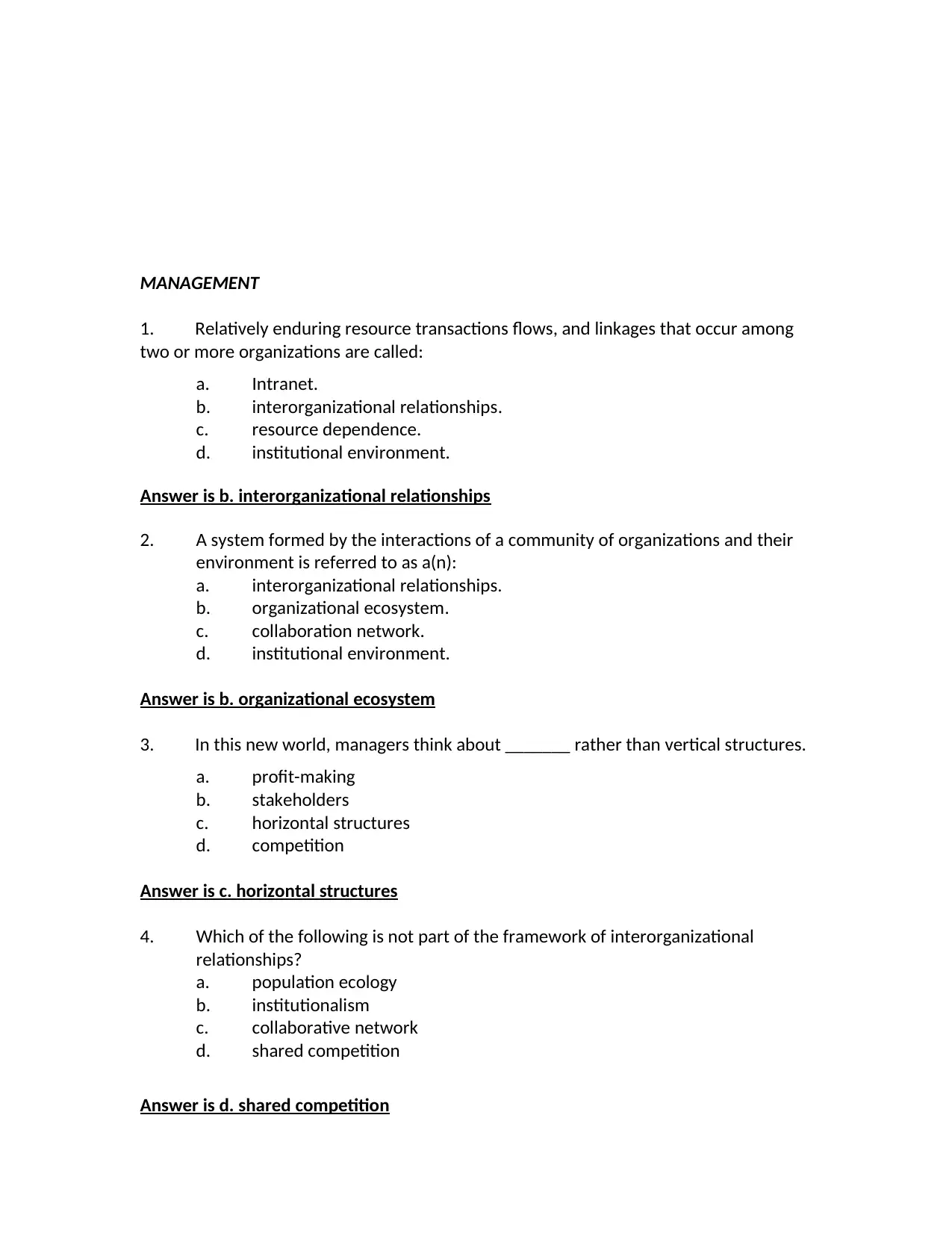
MANAGEMENT
1. Relatively enduring resource transactions flows, and linkages that occur among
two or more organizations are called:
a. Intranet.
b. interorganizational relationships.
c. resource dependence.
d. institutional environment.
Answer is b. interorganizational relationships
2. A system formed by the interactions of a community of organizations and their
environment is referred to as a(n):
a. interorganizational relationships.
b. organizational ecosystem.
c. collaboration network.
d. institutional environment.
Answer is b. organizational ecosystem
3. In this new world, managers think about _______ rather than vertical structures.
a. profit-making
b. stakeholders
c. horizontal structures
d. competition
Answer is c. horizontal structures
4. Which of the following is not part of the framework of interorganizational
relationships?
a. population ecology
b. institutionalism
c. collaborative network
d. shared competition
Answer is d. shared competition
1. Relatively enduring resource transactions flows, and linkages that occur among
two or more organizations are called:
a. Intranet.
b. interorganizational relationships.
c. resource dependence.
d. institutional environment.
Answer is b. interorganizational relationships
2. A system formed by the interactions of a community of organizations and their
environment is referred to as a(n):
a. interorganizational relationships.
b. organizational ecosystem.
c. collaboration network.
d. institutional environment.
Answer is b. organizational ecosystem
3. In this new world, managers think about _______ rather than vertical structures.
a. profit-making
b. stakeholders
c. horizontal structures
d. competition
Answer is c. horizontal structures
4. Which of the following is not part of the framework of interorganizational
relationships?
a. population ecology
b. institutionalism
c. collaborative network
d. shared competition
Answer is d. shared competition
Paraphrase This Document
Need a fresh take? Get an instant paraphrase of this document with our AI Paraphraser
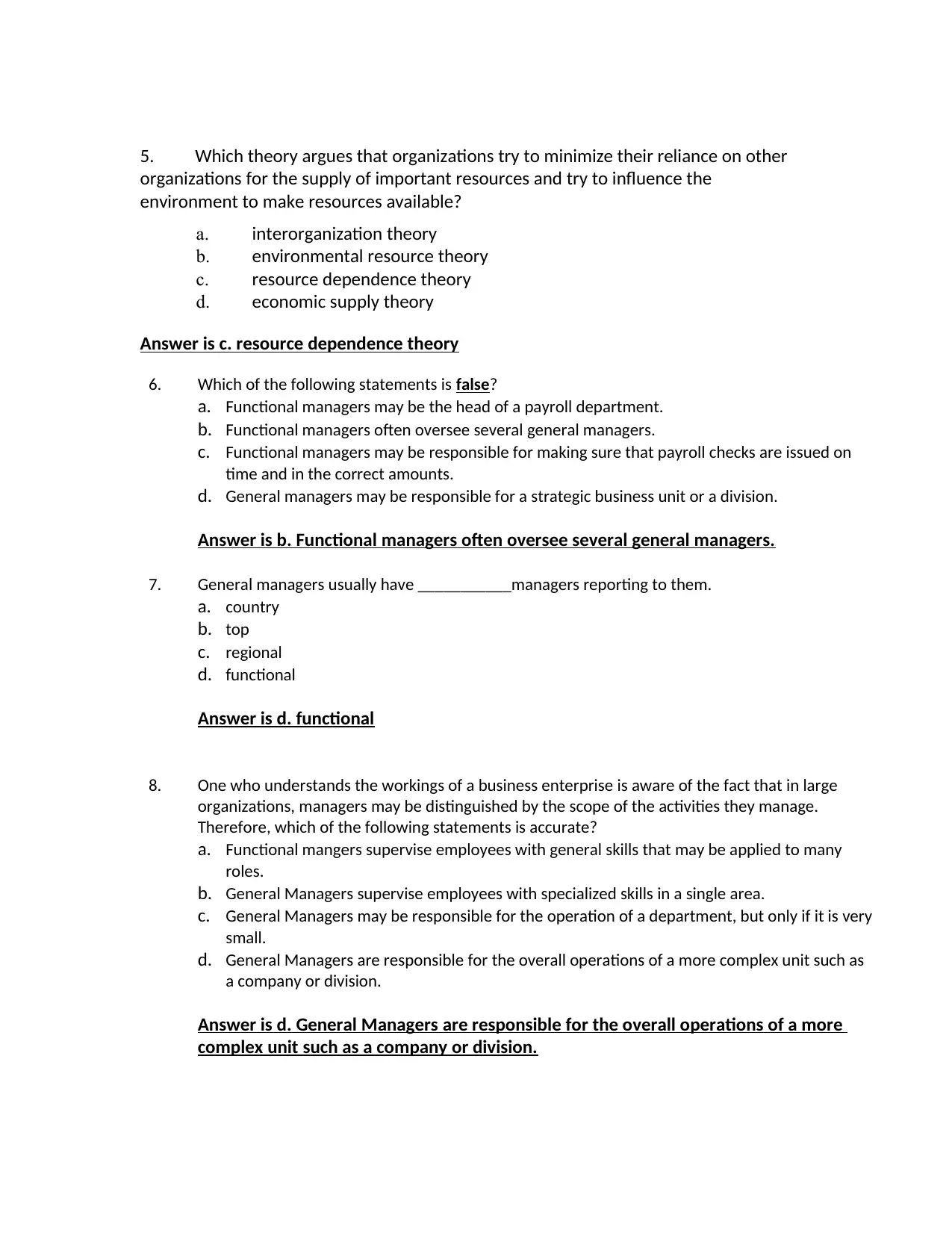
5. Which theory argues that organizations try to minimize their reliance on other
organizations for the supply of important resources and try to influence the
environment to make resources available?
a. interorganization theory
b. environmental resource theory
c. resource dependence theory
d. economic supply theory
Answer is c. resource dependence theory
6. Which of the following statements is false?
a. Functional managers may be the head of a payroll department.
b. Functional managers often oversee several general managers.
c. Functional managers may be responsible for making sure that payroll checks are issued on
time and in the correct amounts.
d. General managers may be responsible for a strategic business unit or a division.
Answer is b. Functional managers often oversee several general managers.
7. General managers usually have ___________managers reporting to them.
a. country
b. top
c. regional
d. functional
Answer is d. functional
8. One who understands the workings of a business enterprise is aware of the fact that in large
organizations, managers may be distinguished by the scope of the activities they manage.
Therefore, which of the following statements is accurate?
a. Functional mangers supervise employees with general skills that may be applied to many
roles.
b. General Managers supervise employees with specialized skills in a single area.
c. General Managers may be responsible for the operation of a department, but only if it is very
small.
d. General Managers are responsible for the overall operations of a more complex unit such as
a company or division.
Answer is d. General Managers are responsible for the overall operations of a more
complex unit such as a company or division.
organizations for the supply of important resources and try to influence the
environment to make resources available?
a. interorganization theory
b. environmental resource theory
c. resource dependence theory
d. economic supply theory
Answer is c. resource dependence theory
6. Which of the following statements is false?
a. Functional managers may be the head of a payroll department.
b. Functional managers often oversee several general managers.
c. Functional managers may be responsible for making sure that payroll checks are issued on
time and in the correct amounts.
d. General managers may be responsible for a strategic business unit or a division.
Answer is b. Functional managers often oversee several general managers.
7. General managers usually have ___________managers reporting to them.
a. country
b. top
c. regional
d. functional
Answer is d. functional
8. One who understands the workings of a business enterprise is aware of the fact that in large
organizations, managers may be distinguished by the scope of the activities they manage.
Therefore, which of the following statements is accurate?
a. Functional mangers supervise employees with general skills that may be applied to many
roles.
b. General Managers supervise employees with specialized skills in a single area.
c. General Managers may be responsible for the operation of a department, but only if it is very
small.
d. General Managers are responsible for the overall operations of a more complex unit such as
a company or division.
Answer is d. General Managers are responsible for the overall operations of a more
complex unit such as a company or division.
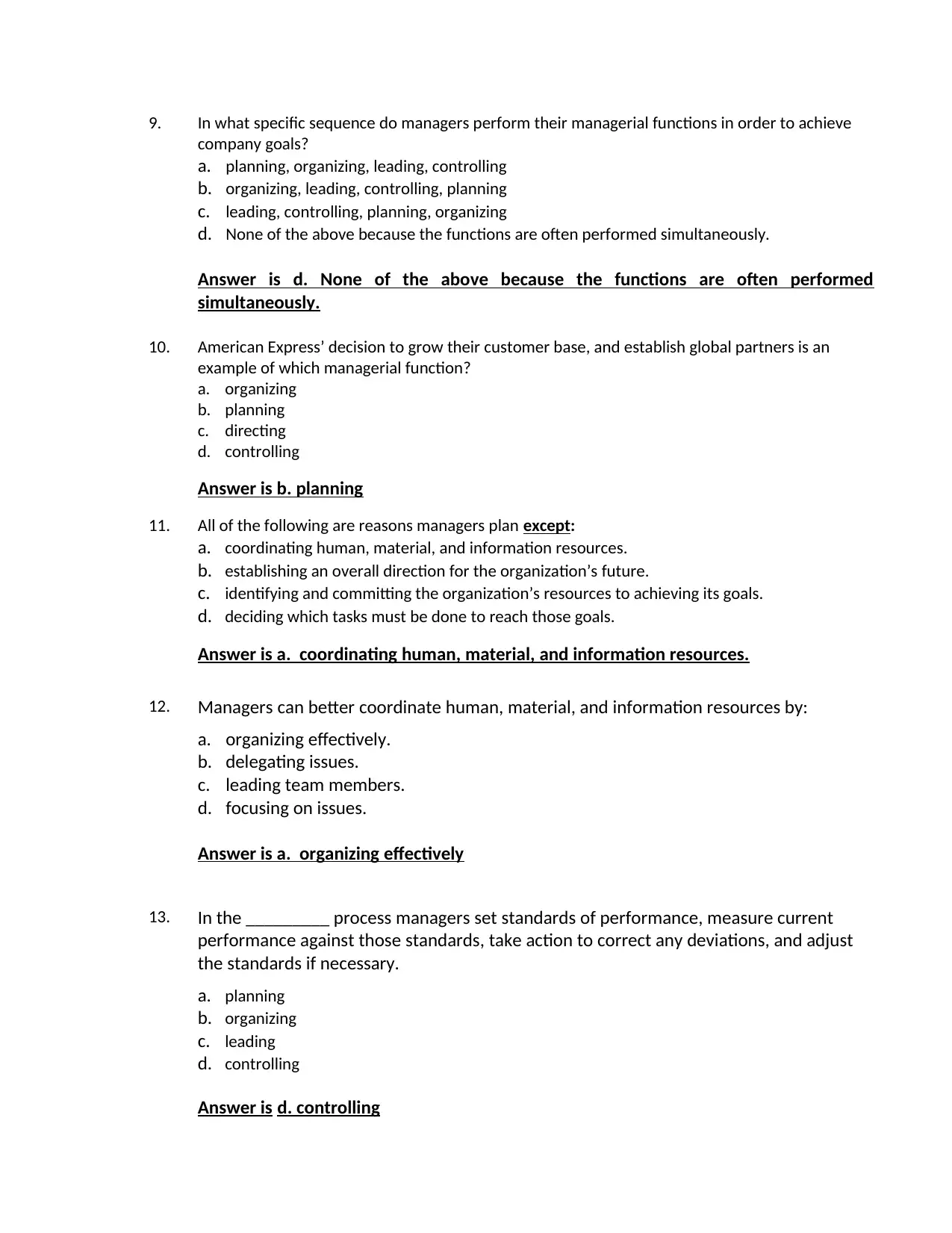
9. In what specific sequence do managers perform their managerial functions in order to achieve
company goals?
a. planning, organizing, leading, controlling
b. organizing, leading, controlling, planning
c. leading, controlling, planning, organizing
d. None of the above because the functions are often performed simultaneously.
Answer is d. None of the above because the functions are often performed
simultaneously.
10. American Express’ decision to grow their customer base, and establish global partners is an
example of which managerial function?
a. organizing
b. planning
c. directing
d. controlling
Answer is b. planning
11. All of the following are reasons managers plan except:
a. coordinating human, material, and information resources.
b. establishing an overall direction for the organization’s future.
c. identifying and committing the organization’s resources to achieving its goals.
d. deciding which tasks must be done to reach those goals.
Answer is a. coordinating human, material, and information resources.
12. Managers can better coordinate human, material, and information resources by:
a. organizing effectively.
b. delegating issues.
c. leading team members.
d. focusing on issues.
Answer is a. organizing effectively
13. In the _________ process managers set standards of performance, measure current
performance against those standards, take action to correct any deviations, and adjust
the standards if necessary.
a. planning
b. organizing
c. leading
d. controlling
Answer is d. controlling
company goals?
a. planning, organizing, leading, controlling
b. organizing, leading, controlling, planning
c. leading, controlling, planning, organizing
d. None of the above because the functions are often performed simultaneously.
Answer is d. None of the above because the functions are often performed
simultaneously.
10. American Express’ decision to grow their customer base, and establish global partners is an
example of which managerial function?
a. organizing
b. planning
c. directing
d. controlling
Answer is b. planning
11. All of the following are reasons managers plan except:
a. coordinating human, material, and information resources.
b. establishing an overall direction for the organization’s future.
c. identifying and committing the organization’s resources to achieving its goals.
d. deciding which tasks must be done to reach those goals.
Answer is a. coordinating human, material, and information resources.
12. Managers can better coordinate human, material, and information resources by:
a. organizing effectively.
b. delegating issues.
c. leading team members.
d. focusing on issues.
Answer is a. organizing effectively
13. In the _________ process managers set standards of performance, measure current
performance against those standards, take action to correct any deviations, and adjust
the standards if necessary.
a. planning
b. organizing
c. leading
d. controlling
Answer is d. controlling
⊘ This is a preview!⊘
Do you want full access?
Subscribe today to unlock all pages.

Trusted by 1+ million students worldwide
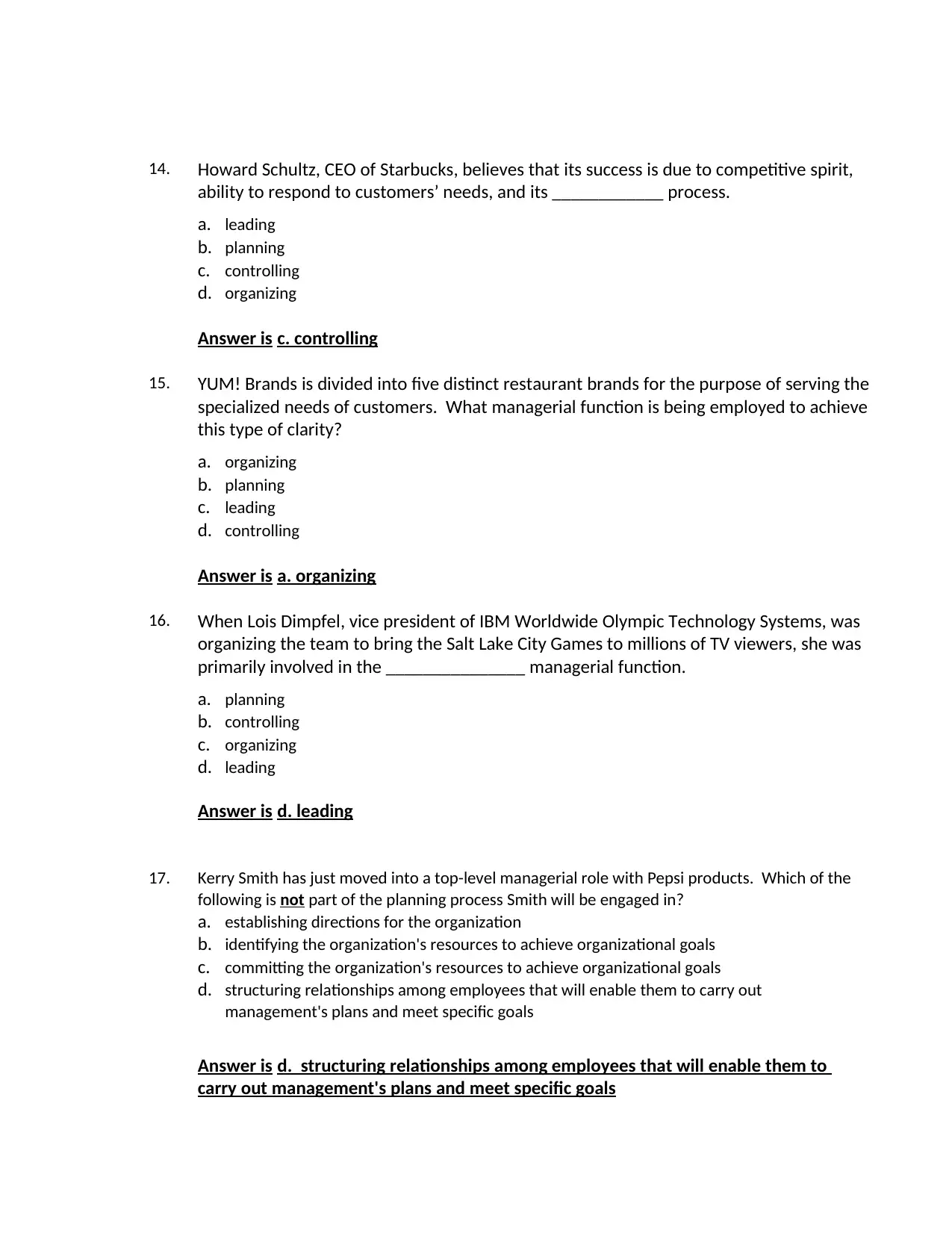
14. Howard Schultz, CEO of Starbucks, believes that its success is due to competitive spirit,
ability to respond to customers’ needs, and its ____________ process.
a. leading
b. planning
c. controlling
d. organizing
Answer is c. controlling
15. YUM! Brands is divided into five distinct restaurant brands for the purpose of serving the
specialized needs of customers. What managerial function is being employed to achieve
this type of clarity?
a. organizing
b. planning
c. leading
d. controlling
Answer is a. organizing
16. When Lois Dimpfel, vice president of IBM Worldwide Olympic Technology Systems, was
organizing the team to bring the Salt Lake City Games to millions of TV viewers, she was
primarily involved in the _______________ managerial function.
a. planning
b. controlling
c. organizing
d. leading
Answer is d. leading
17. Kerry Smith has just moved into a top-level managerial role with Pepsi products. Which of the
following is not part of the planning process Smith will be engaged in?
a. establishing directions for the organization
b. identifying the organization's resources to achieve organizational goals
c. committing the organization's resources to achieve organizational goals
d. structuring relationships among employees that will enable them to carry out
management's plans and meet specific goals
Answer is d. structuring relationships among employees that will enable them to
carry out management's plans and meet specific goals
ability to respond to customers’ needs, and its ____________ process.
a. leading
b. planning
c. controlling
d. organizing
Answer is c. controlling
15. YUM! Brands is divided into five distinct restaurant brands for the purpose of serving the
specialized needs of customers. What managerial function is being employed to achieve
this type of clarity?
a. organizing
b. planning
c. leading
d. controlling
Answer is a. organizing
16. When Lois Dimpfel, vice president of IBM Worldwide Olympic Technology Systems, was
organizing the team to bring the Salt Lake City Games to millions of TV viewers, she was
primarily involved in the _______________ managerial function.
a. planning
b. controlling
c. organizing
d. leading
Answer is d. leading
17. Kerry Smith has just moved into a top-level managerial role with Pepsi products. Which of the
following is not part of the planning process Smith will be engaged in?
a. establishing directions for the organization
b. identifying the organization's resources to achieve organizational goals
c. committing the organization's resources to achieve organizational goals
d. structuring relationships among employees that will enable them to carry out
management's plans and meet specific goals
Answer is d. structuring relationships among employees that will enable them to
carry out management's plans and meet specific goals
Paraphrase This Document
Need a fresh take? Get an instant paraphrase of this document with our AI Paraphraser
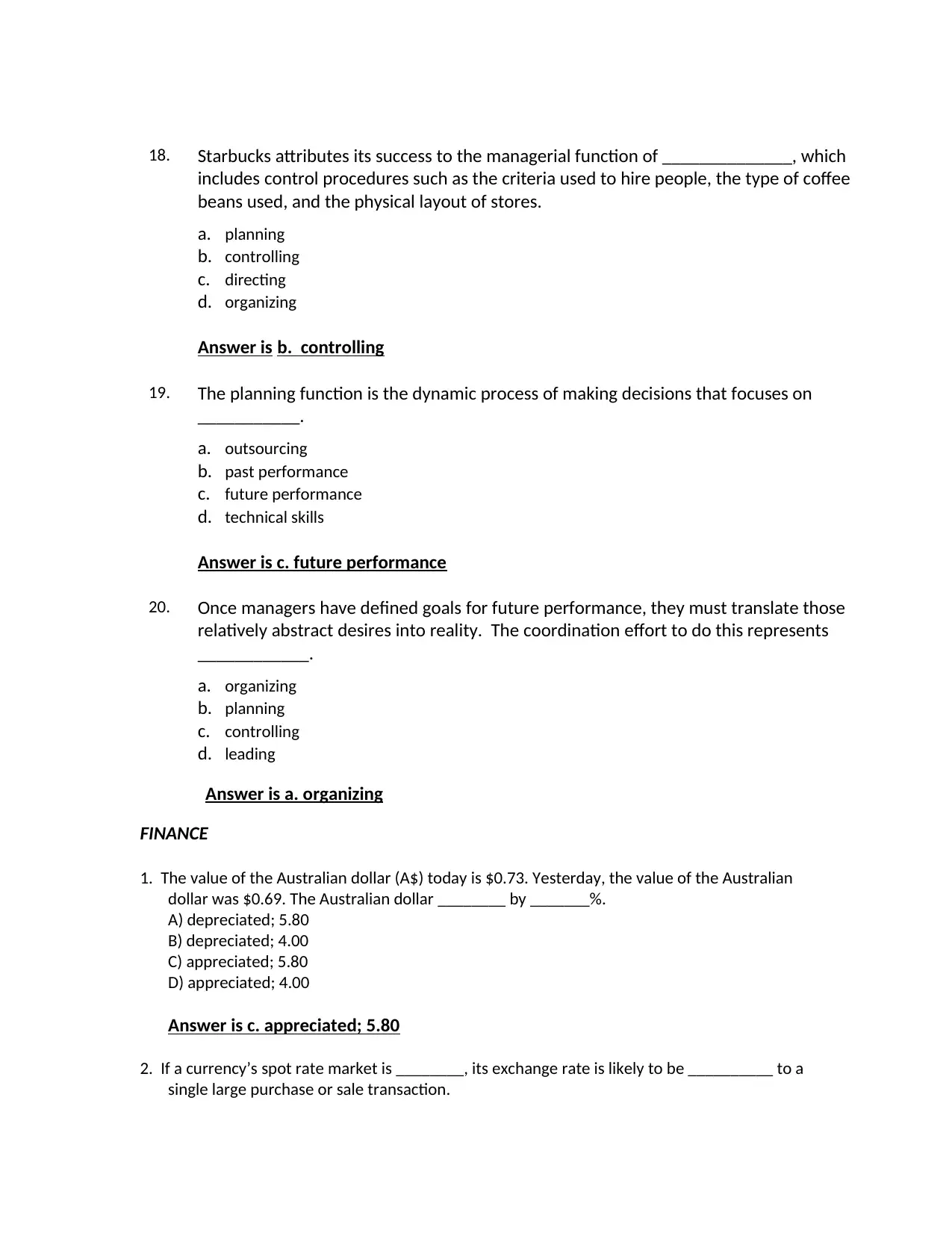
18. Starbucks attributes its success to the managerial function of ______________, which
includes control procedures such as the criteria used to hire people, the type of coffee
beans used, and the physical layout of stores.
a. planning
b. controlling
c. directing
d. organizing
Answer is b. controlling
19. The planning function is the dynamic process of making decisions that focuses on
___________.
a. outsourcing
b. past performance
c. future performance
d. technical skills
Answer is c. future performance
20. Once managers have defined goals for future performance, they must translate those
relatively abstract desires into reality. The coordination effort to do this represents
____________.
a. organizing
b. planning
c. controlling
d. leading
Answer is a. organizing
FINANCE
1. The value of the Australian dollar (A$) today is $0.73. Yesterday, the value of the Australian
dollar was $0.69. The Australian dollar ________ by _______%.
A) depreciated; 5.80
B) depreciated; 4.00
C) appreciated; 5.80
D) appreciated; 4.00
Answer is c. appreciated; 5.80
2. If a currency’s spot rate market is ________, its exchange rate is likely to be __________ to a
single large purchase or sale transaction.
includes control procedures such as the criteria used to hire people, the type of coffee
beans used, and the physical layout of stores.
a. planning
b. controlling
c. directing
d. organizing
Answer is b. controlling
19. The planning function is the dynamic process of making decisions that focuses on
___________.
a. outsourcing
b. past performance
c. future performance
d. technical skills
Answer is c. future performance
20. Once managers have defined goals for future performance, they must translate those
relatively abstract desires into reality. The coordination effort to do this represents
____________.
a. organizing
b. planning
c. controlling
d. leading
Answer is a. organizing
FINANCE
1. The value of the Australian dollar (A$) today is $0.73. Yesterday, the value of the Australian
dollar was $0.69. The Australian dollar ________ by _______%.
A) depreciated; 5.80
B) depreciated; 4.00
C) appreciated; 5.80
D) appreciated; 4.00
Answer is c. appreciated; 5.80
2. If a currency’s spot rate market is ________, its exchange rate is likely to be __________ to a
single large purchase or sale transaction.
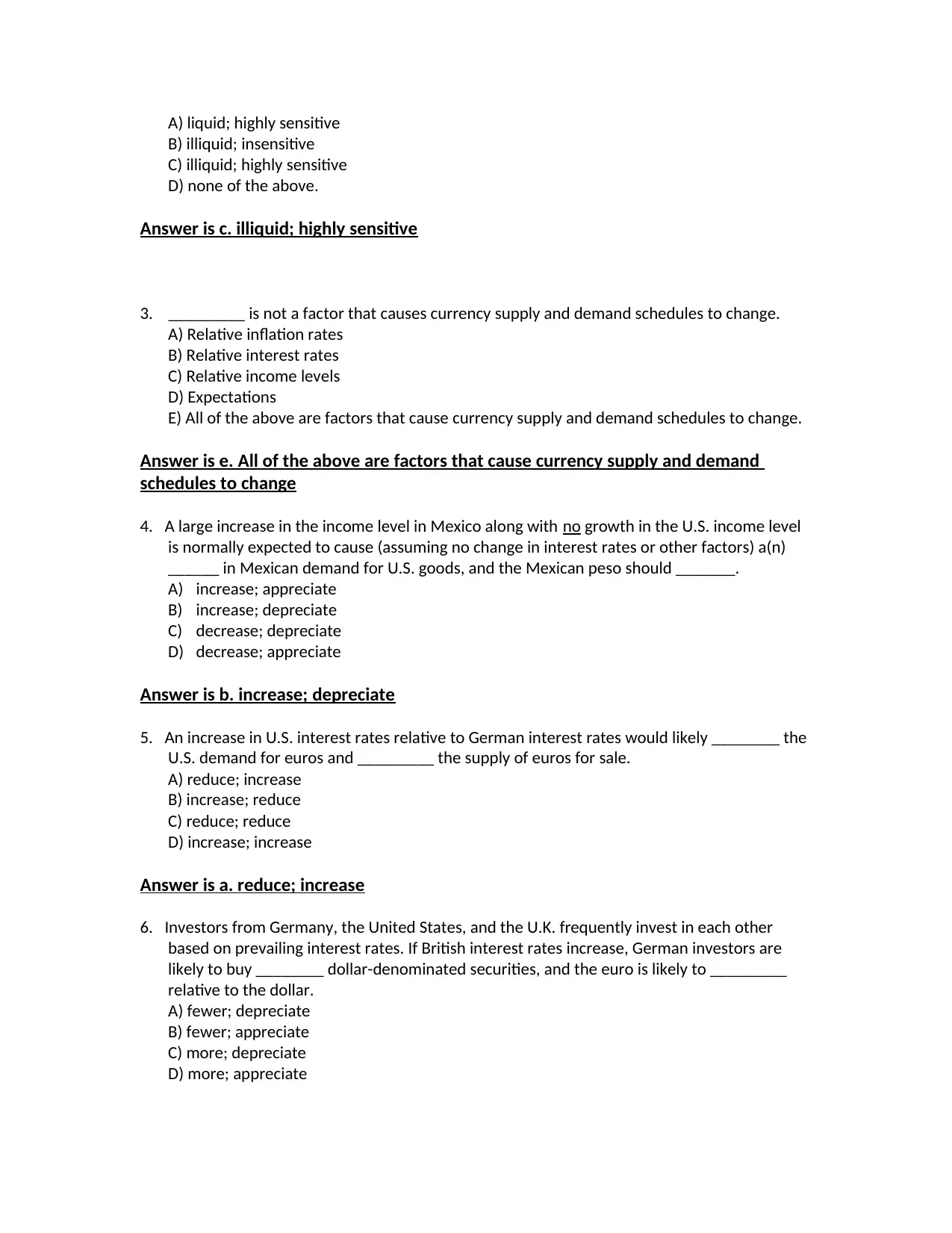
A) liquid; highly sensitive
B) illiquid; insensitive
C) illiquid; highly sensitive
D) none of the above.
Answer is c. illiquid; highly sensitive
3. _________ is not a factor that causes currency supply and demand schedules to change.
A) Relative inflation rates
B) Relative interest rates
C) Relative income levels
D) Expectations
E) All of the above are factors that cause currency supply and demand schedules to change.
Answer is e. All of the above are factors that cause currency supply and demand
schedules to change
4. A large increase in the income level in Mexico along with no growth in the U.S. income level
is normally expected to cause (assuming no change in interest rates or other factors) a(n)
______ in Mexican demand for U.S. goods, and the Mexican peso should _______.
A) increase; appreciate
B) increase; depreciate
C) decrease; depreciate
D) decrease; appreciate
Answer is b. increase; depreciate
5. An increase in U.S. interest rates relative to German interest rates would likely ________ the
U.S. demand for euros and _________ the supply of euros for sale.
A) reduce; increase
B) increase; reduce
C) reduce; reduce
D) increase; increase
Answer is a. reduce; increase
6. Investors from Germany, the United States, and the U.K. frequently invest in each other
based on prevailing interest rates. If British interest rates increase, German investors are
likely to buy ________ dollar-denominated securities, and the euro is likely to _________
relative to the dollar.
A) fewer; depreciate
B) fewer; appreciate
C) more; depreciate
D) more; appreciate
B) illiquid; insensitive
C) illiquid; highly sensitive
D) none of the above.
Answer is c. illiquid; highly sensitive
3. _________ is not a factor that causes currency supply and demand schedules to change.
A) Relative inflation rates
B) Relative interest rates
C) Relative income levels
D) Expectations
E) All of the above are factors that cause currency supply and demand schedules to change.
Answer is e. All of the above are factors that cause currency supply and demand
schedules to change
4. A large increase in the income level in Mexico along with no growth in the U.S. income level
is normally expected to cause (assuming no change in interest rates or other factors) a(n)
______ in Mexican demand for U.S. goods, and the Mexican peso should _______.
A) increase; appreciate
B) increase; depreciate
C) decrease; depreciate
D) decrease; appreciate
Answer is b. increase; depreciate
5. An increase in U.S. interest rates relative to German interest rates would likely ________ the
U.S. demand for euros and _________ the supply of euros for sale.
A) reduce; increase
B) increase; reduce
C) reduce; reduce
D) increase; increase
Answer is a. reduce; increase
6. Investors from Germany, the United States, and the U.K. frequently invest in each other
based on prevailing interest rates. If British interest rates increase, German investors are
likely to buy ________ dollar-denominated securities, and the euro is likely to _________
relative to the dollar.
A) fewer; depreciate
B) fewer; appreciate
C) more; depreciate
D) more; appreciate
⊘ This is a preview!⊘
Do you want full access?
Subscribe today to unlock all pages.

Trusted by 1+ million students worldwide
1 out of 25
Related Documents
Your All-in-One AI-Powered Toolkit for Academic Success.
+13062052269
info@desklib.com
Available 24*7 on WhatsApp / Email
![[object Object]](/_next/static/media/star-bottom.7253800d.svg)
Unlock your academic potential
Copyright © 2020–2025 A2Z Services. All Rights Reserved. Developed and managed by ZUCOL.




